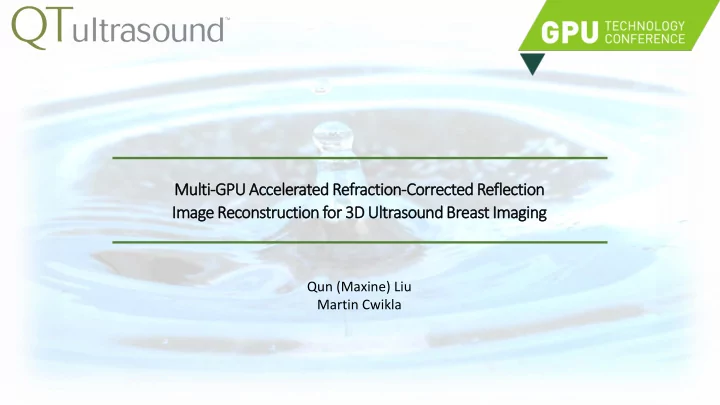

Multi-GPU Accelerated Refraction-Corrected Reflection Image Reconstruction for 3D Ultrasound Breast Imaging Qun (Maxine) Liu Martin Cwikla
Presentation Overview Background Motivation & Problem Statement Technical Design GPU Implementation Results Contact Information
Scanner Introduction For breast tissue evaluation; Quantitative transmission image; Qualitative reflection image; No radiation; Patient comfort improvement. Figure 1 QTultrasound scanner
Background Scanner Geometry Figure 2 Five scanning arrays mounted on the Figure 3 Geometry of three reflection tri-channel arrays and a pair of transmission arrays
Background Data Acquisition Transmitted pulse Echo from skin surface Echo from Voltage lesion front face Echo from lesion back face t = 2d / c Time d Transducer Receiver
Background B-mode Scan and Acoustic Wave Behavior Figure 4 Sample of B-mode (brightness mode). Figure 5 Acoustic wave behavior between the Image driven. inhomogeneous border of two different mediums. http://www.sonoguide.com/physics.html
Background Image Reconstruction Algorithm Mapping transmission results into Transmission Image Preprocessing reflection image space. Support Function Generation Signal gain control for attenuation. Ray (data) driven B-mode Refraction-corrected Ray Tracing back-projection tomography Image Postprocessing Readability improvement
Background Refraction-Corrected Ray Tracing 𝑒𝑡 𝑜 𝑒𝒔 𝑒 Eikonal equation: = 𝛼𝑜 Euler step method: 𝑒𝑡 s: arc length along the ray; r: ray position vector in 3D; n: refractive index. 𝑜 𝒔 = 𝑑 0 𝑑(𝒔) For i = 1,… 𝒔 𝑗+1 = 𝒔 𝑗 + ℎ ∙ 𝑣 𝒔 𝑗+1 2 h: step length; u: unit tangent vector to the ray path.
Background Compounding to Tomography
Challenges for Parallel Computation Sequential operation of Large amount of memory File access speed limitation refraction-corrected ray tracing management Each step of each ray depends on the previous step’s position Data writing and reading and refractive index and the Unknowns: 32390540 pixels; between pipeline stages current step’s refractive index; allows for all the operations in each stage to be computed Acquired data: around 1.88 independently; Each pixel’s signal weighting is GB; contributed by multiple rays; However, the data throughput Computation data: around 9.4 on an SSD or a hard drive Each ray behavior is GB. becomes a limiting factor. unpredictable in terms of position ranges.
Design Parallelism with multi-core CPU and GPU streaming processors CPU multiple worker threads . . . . . . View 30 … … View 1 View 6 View 54 View 60 Probe 2 Probe 1 Probe 3 . . . . . . . . . . . . . . . . . . Level 140 Level 1 Level 70 . . . . . . Ray 1 Ray 192 Ray 94 SubRay 1 SubRay 3 SubRay 2 Refraction corrected Work group ray tracing Worker thread join()
Design Ray Tracing in Parallel 3D sparse matrix Dictionary of Keys (DOK) Pixel position-> key Weight-> Value Time sample-> Value
Design Concurrent Operations of CPU and GPU cudaMalloc (&dev, size); … cudaStream_t stream[nStreams]; Create streams for each view computation For (int iStream = 1; iStream <= nStreams; ++iStream) cudaStreamCreate (&stream[iStream]); cudaEvent_t event; Only one event needed to be created cudaEventCreate (&event); For (int iView = 1; iView < nViews; ++iView) { …read the data for iView cudaMemcpyAsync (dev, host, size, H2D, stream[iView]); Asynchronous with stream kernel <<< grid, block, 0, stream[iView]>>> (…, dev, …); if (iView != nViews) { cudaEventRecord (event, stream[iView]); Wait for the previous event done cudaStreamWaitEvent(stream[iView + 1], event, 0); } } cudaMemcpy (host, device, size, D2H); …destroy stream and event
Design Memory Contention Solution Thread group View 1 View 2 View 3 View 4 View 5 View 6 View 7 View 8 View 9 … … … … … … Sufficient Memory Memory memory wait wait Thread group available Sleep (5) Exception View 20 View 45 Finished Aborted Finished Finished Finished Finished
Hardware Selection Stability and reliability: long-term product; High single precision floating-point performance: 4.20 TFlops; Tesla K40 GPU Large memory to support multiple CPU worker threads operation: 12 GB.
Implementation Software Architecture Design Interface to rest of GUI Standalone production software Read parameters, order of algorithm operations, etc, Pipeline Layer from a configuration file Object-oriented API for each stage of Interface Layer reconstruction algorithm Manage GPU memory; CPU and GPU data transfer; Host Layer Call GPU kernels and check kernel errors; schedule asynchronous operations; Support multi-GPUs GPU Layer GPU kernels implementation
Performance Test (individual functions) Functions Single CPU time Single GPU time Speedup Bilinear interpolation 1930.00 33.28 57.99X Blurring filter (FFT included) 15660.00 129.17 121.24X L1 norm fit third-order 100.00 7.24 13.81X polynomial Nearest points mapping 6850.00 39.98 171.34X Compounding images 366800.00 4403.09 83.31X Dynamic gain for images 910.01 42.88 21.22X Note: The calculation of GPU time includes data transfer from host to device and back from device to host. All times are given in milliseconds.
Result Performance Test (overall) Reconstruction Stage Single CPU Single GPU Single GPU Two GPU Two GPU time time speedup time speedup Preprocessing and 34.09 9.36 3.64X 7.72 4.42X Support Function Refraction-Corrected 1899.98 63.29 30.02X 45.53 41.73X Ray Tracing Compounding Views 39.33 0.84 46.71X 0.84 46.71X Entire Reflection 2108.40 79.16 26.63X 54.57 38.64X Reconstruction Note: All times are presented in seconds.
Result Case Images 1: Multiple Cysts Figure 10 Comparison with mammography, hand-held ultrasound Figure 9 Coronal, Axial and Sagittal images present multiple cysts.
Result Case Images 2: Invasive Ductal Carcinoma Figure 12 Comparison with mammography, hand-held ultrasound Figure 11 Coronal, Axial and Sagittal images present invasive ductal carcinoma
Contact Information Qun (Maxine) Liu: Martin Cwikla: Scientist Senior Software Engineer QTultrasound, LLC QTultrasound, LLC 3216 S Highland Drive, Suite 100, 3216 S Highland Drive, Suite 100, Salt Lake City, UT 84121 Salt Lake City, UT 84121 Email: maxine.liu@qtultrasound.com Email: martin.cwikla@qtultrasound.com Personal Email: maxineliuqun@gmail.com Personal Email: mcwikla@ieee.org Cell: 979-703-9475 Cell: 801-512-1027 Website: http://qunmaxineliu.weebly.com/
Thank you
Recommend
More recommend